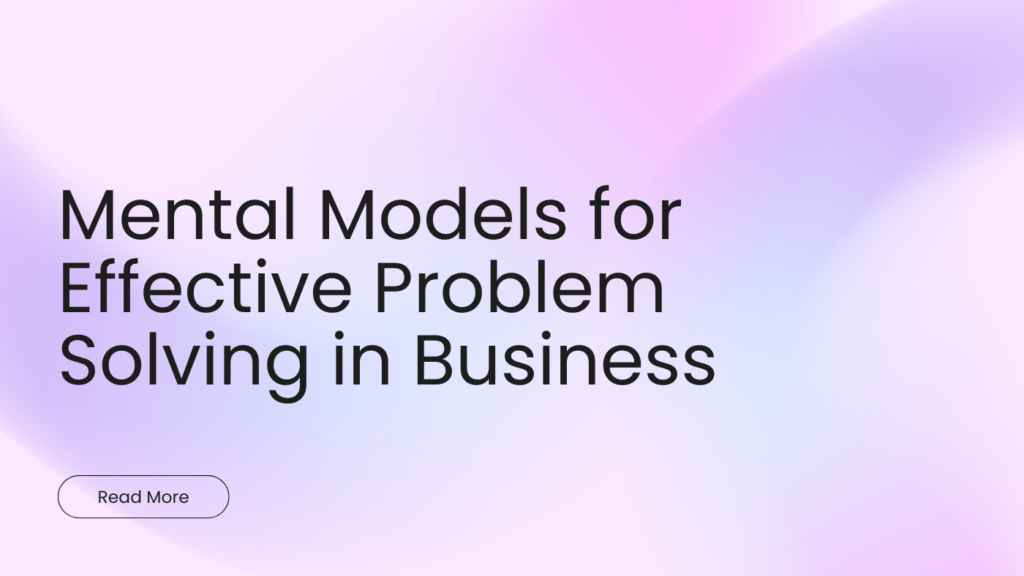Mental Models for Effective Problem Solving in Business: A Comprehensive Guide
In the fast-paced world of business, effective problem-solving is paramount. Successful leaders and entrepreneurs don’t just react to challenges; they anticipate them, analyze them strategically, and implement solutions with precision. A key component of this ability is a robust collection of mental models for problem solving. This guide explores the power of mental models and how they can be leveraged for business problem solving and strategy development models.
What are Mental Models?
Mental models are frameworks or thought processes that help us understand and navigate the world. They’re shortcuts our brains use to simplify complex situations, allowing us to make quicker, more informed decisions. Think of them as reusable blueprints for thinking. As Charlie Munger, the renowned investor and Warren Buffett’s longtime business partner, famously said, “You’ve got to have models in your head. And you’ve got to array your experience—both vicarious and direct—on this latticework of models.” Developing a diverse set of mental models equips you with the tools to tackle a wide range of business challenges.
Essentially, these models are simplified representations of how things work. They are not necessarily perfect, but they are useful for making predictions and understanding complex systems. They allow us to see patterns, anticipate consequences, and avoid common pitfalls.
Why are Mental Models Crucial for Business Problem Solving?
Here’s why incorporating mental models for problem solving is essential for any business professional:
- Improved Decision-Making: Mental models provide a framework for evaluating options and predicting outcomes, leading to more informed and effective decisions.
- Enhanced Problem Definition: By providing different perspectives, mental models help you understand the root cause of a problem, rather than just treating the symptoms.
- Strategic Thinking: Strategy development models, a type of mental model, enable you to anticipate future trends and develop proactive strategies to capitalize on opportunities and mitigate risks.
- Better Communication: Mental models provide a shared language and understanding, facilitating clearer communication and collaboration within teams.
- Increased Adaptability: In today’s rapidly changing business environment, a diverse set of mental models allows you to adapt quickly to new challenges and opportunities.
Key Mental Models for Business Leaders
Let’s explore some powerful mental models that can be applied to business problem solving:
1. First Principles Thinking
Description: Breaking down a complex problem into its fundamental truths and reasoning upwards from there. This model encourages you to question assumptions and build your understanding from the ground up.
Application: When launching a new product, instead of relying on industry best practices, analyze the core needs of your target market and design a solution that directly addresses those needs.
Example: Elon Musk famously used First Principles Thinking to dramatically reduce the cost of rocket production at SpaceX. He questioned the traditional materials and processes, leading to innovative solutions.
Reference: Farnam Street – First Principles: The Building Blocks of True Knowledge
2. Occam’s Razor
Description: The simplest explanation is usually the best. This model encourages you to avoid unnecessary complexity and focus on the most straightforward solution.
Application: When faced with declining sales, start by investigating the most obvious factors, such as pricing, marketing, or product quality, before assuming more complex issues.
Example: In troubleshooting technical issues, start with the most basic potential causes (e.g., power outage, disconnected cable) before assuming a more complex software bug.
Reference: Britannica – Occam’s razor
3. The 80/20 Rule (Pareto Principle)
Description: Approximately 80% of effects come from 20% of causes. This model helps you identify and prioritize the most impactful activities.
Application: Focus your marketing efforts on the 20% of customers who generate 80% of your revenue. Identify the 20% of product features that are used 80% of the time and prioritize their improvement.
Example: A software company might find that 80% of bug reports relate to 20% of the codebase. Focusing on refactoring that 20% can dramatically improve stability.
Reference: Corporate Finance Institute – 80/20 Rule (Pareto Principle)
4. Inversion
Description: Instead of trying to solve a problem directly, think about how to make it worse. This can reveal hidden assumptions and potential pitfalls.
Application: Before launching a new product, ask yourself, “How could we make this product fail?” This will help you identify and address potential weaknesses.
Example: Instead of focusing on how to increase employee engagement, consider what actions would actively disengage employees. Avoid those!
Reference: Farnam Street – Inversion: The Crucial Thinking Skill Nobody Ever Taught You
5. Second-Order Thinking
Description: Consider the consequences of the consequences. This model encourages you to think beyond the immediate impact of a decision and anticipate its ripple effects.
Application: Before implementing a cost-cutting measure, consider its potential impact on employee morale, customer satisfaction, and long-term innovation.
Example: Implementing stricter attendance policies might initially reduce absenteeism, but could also lead to decreased employee morale and increased turnover in the long run.
Reference: Farnam Street – Second-Order Consequences
6. Game Theory
Description: Analyzing strategic interactions between different parties, considering their potential actions and reactions.
Application: When entering a new market, anticipate how your competitors will respond and develop strategies to counter their moves.
Example: Pricing strategies are often heavily influenced by game theory, anticipating how competitors will adjust their prices in response to your own changes.
Reference: Investopedia – Game Theory
7. Systems Thinking
Description: Viewing a problem as part of a larger interconnected system, rather than an isolated event.
Application: When addressing supply chain disruptions, consider the impact on all stakeholders, from suppliers to customers, and develop a holistic solution that addresses the root causes.
Example: Reducing waste requires looking at the entire production and consumption system, not just the waste disposal process.
Reference: The Systems Thinker – What is Systems Thinking?
8. The Map is Not the Territory
Description: Our understanding of reality (the map) is always a simplification and imperfect representation of the actual reality (the territory).
Application: Recognize that market research reports are just snapshots in time and may not fully reflect the evolving needs and preferences of customers. Continuously validate your assumptions with real-world data.
Example: A financial model is useful for making projections, but it’s important to remember that it’s based on assumptions and can’t perfectly predict the future.
Reference: Farnam Street – The Map Is Not the Territory
How to Develop and Apply Mental Models
Building a library of useful mental models is an ongoing process. Here are some tips:
- Read Widely: Explore diverse fields like science, history, psychology, and philosophy. The more you learn, the more mental models you’ll encounter.
- Learn from Experts: Study the thinking processes of successful leaders and entrepreneurs. Read biographies, listen to interviews, and analyze their strategies.
- Practice Application: Actively apply mental models to real-world problems. Experiment with different models and see which ones are most effective in different situations.
- Reflect and Refine: Regularly review your mental models and update them based on your experiences. Challenge your assumptions and be open to new perspectives.
- Keep a Mental Model Journal: Document the mental models you learn, along with examples of how you’ve applied them. This will help you internalize the concepts and make them readily accessible.
Conclusion
Mastering mental models for problem solving is a significant investment in your professional development. By incorporating these frameworks into your thinking, you can unlock new levels of strategic insight, improve your decision-making, and ultimately achieve greater success in business. From strategy development models to understanding the underlying principles of complex systems, these tools will help you navigate the challenges of the business world with greater confidence and effectiveness. Embrace the power of mental models and elevate your problem-solving abilities to new heights. By consistently applying and refining your mental models, you’ll become a more effective leader, a more insightful strategist, and a more resilient problem solver.


